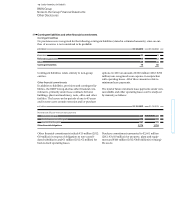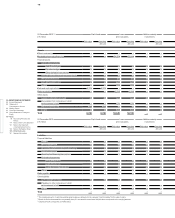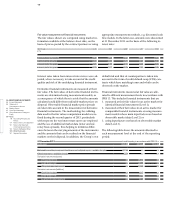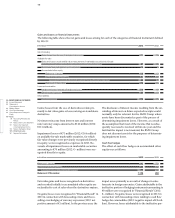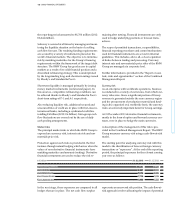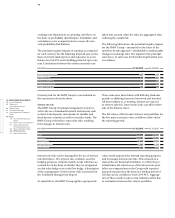BMW 2013 Annual Report Download - page 153
Download and view the complete annual report
Please find page 153 of the 2013 BMW annual report below. You can navigate through the pages in the report by either clicking on the pages listed below, or by using the keyword search tool below to find specific information within the annual report.
153 GROUP FINANCIAL STATEMENTS
tion of commodity hedges amounting to € 8 million (2012:
gain of € 67 million) were recognised in “Financial Result”.
At 31 December 2013 the BMW Group held derivative
financial instruments (mainly option and forward cur-
rency contracts) with terms of up to 60 months (2012:
72 months), as a general rule in order to hedge cur-
rency
risks attached to future transactions. These de-
rivative
instruments are intended to hedge forecast
sales denominated in a foreign currency over the com-
ing 60 months. The income statement impact of the
hedged cash flows will be recognised as a general rule
in the same periods in which external revenues are
recognised. It is expected that € 162 million of net gains,
recognised in equity at the end of the reporting pe-
riod,
will be reclassified to the income statement (2012:
€ 26 million).
At 31 December 2013 the BMW Group held derivative
financial instruments (mostly interest rate swaps) with
terms of up to 13 months (2012: 25 months) to hedge in-
terest rate risks. These derivative instruments are in-
tended to hedge interest-rate risks arising on financial
instruments with variable interest payments over the
coming 13 months. The income statement impact of the
hedged cash flows will be recognised as a general rule in
the same periods over which the relevant interest rates
are fixed. It is not expected that any net gains or net
losses, recognised in equity at the end of the reporting
period, will be reclassified to the income statement in
the coming financial year (2012: € – million).
At 31 December 2013 the BMW Group held derivative
financial instruments (mostly commodity swaps) with
terms of up to 60 months (2012: 60 months) to hedge
raw materials price risks attached to future transactions
over the coming 60 months. The income statement im-
pact of the hedged cash flows will be recognised as a
general rule in the same period in which the derivative
instruments mature. It is expected that € 60 million of net
losses, recognised in equity at the end of the reporting
period, will be reclassified to the income statement in the
coming financial year (2012: net gains of € 5 million).
Fair value hedges
The following table shows gains and losses on hedging
instruments and hedged items which are deemed to be
part of a fair value hedge relationship:
The difference between the gains / losses on hedging
instruments (mostly interest rate swaps) and the results
recognised on hedged items represents the ineffective
portion of fair value hedges.
Fair value hedges are mainly used to hedge the market
prices of bonds, other financial liabilities and receivables
from sales financing.
Bad debt risk
Notwithstanding the existence of collateral accepted,
the carrying amounts of financial assets generally take
account of the maximum credit risk arising from the
possibility that the counterparties will not be able to fulfil
their contractual obligations. The maximum credit risk
for irrevocable credit commitments relating to credit card
business amounts to € 943 million (2012: € 969 million).
The equivalent figure for dealer financing is € 19,856 mil-
lion (2012: € 18,157 million).
In the case of performance relationships underlying
non-derivative financial instruments, collateral will be
required, information on the credit-standing of the
counterparty obtained or historical data based on the
existing business relationship (i. e. payment patterns to
date) reviewed in order to minimise the credit risk, all
depending on the nature and amount of the exposure
that the BMW Group is proposing to enter into.
Within the financial services business, the financed
items (e. g. vehicles, equipment and property) in the re-
tail customer and dealer lines of business serve as first-
ranking collateral with a recoverable value. Security is
also put up by customers in the form of collateral asset
pledges, asset assignment and first-ranking mortgages,
supplemented where appropriate by warranties and
guarantees. If an item previously accepted as collateral
is acquired, it undergoes a multi-stage process of repos-
session and disposal in accordance with the legal situa-
in € million 31. 12. 2013 31. 12. 2012
Gains / losses on hedging instruments designated as part of a fair value hedge relationship – 525 127
Gains / loss from hedged items 503 – 140
Ineffectiveness of fair value hedges – 22 – 13




